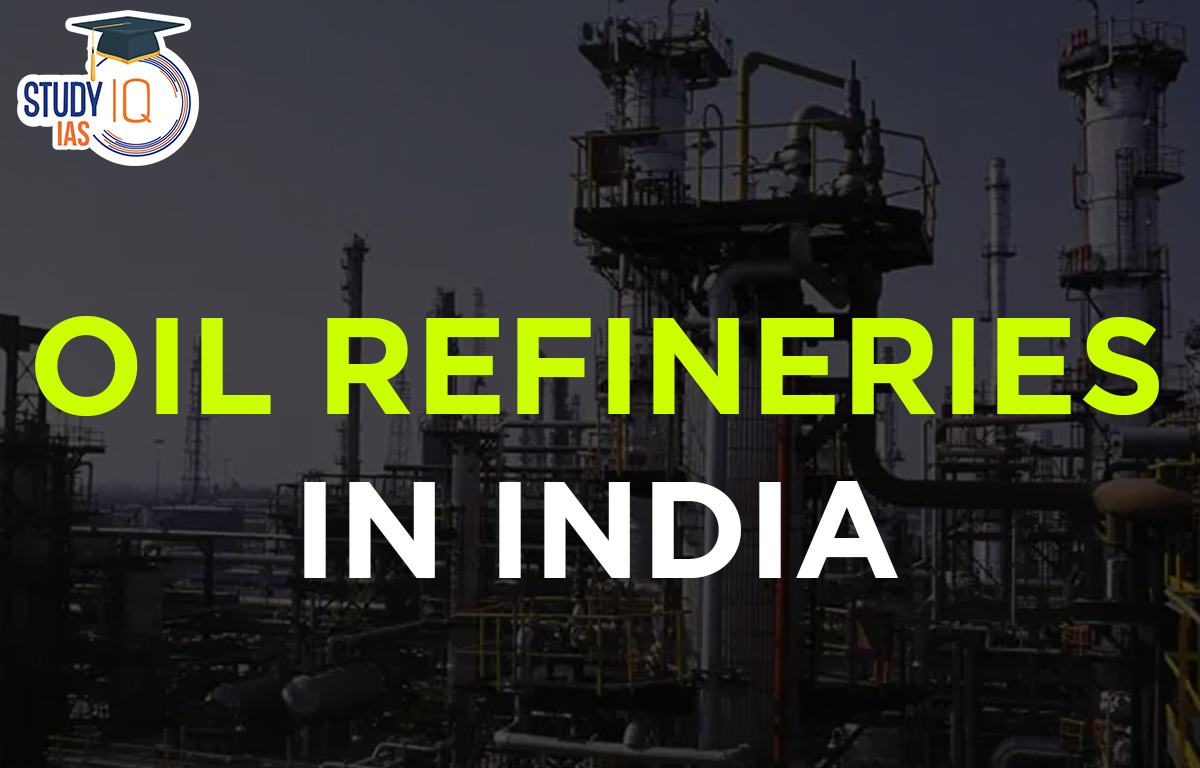Table of Contents
Oil Refineries in India
Oil Refineries in India: An industrial facility known as an oil refinery turns or refines crude oil into a variety of petroleum products that can be used, including diesel, gasoline, and heating oils like kerosene. Refinery services are regarded as a downstream sector of the oil and gas industry since oil refineries effectively act as the second step in the crude oil production process after the actual extraction of crude oil upstream. Distillation, the first step in the refining process, involves heating crude oil to extremely high temperatures in order to separate the various hydrocarbons.
Oil Refineries in India List
The generation of transportation fuels and other fuels relies heavily on oil refineries. Once separated, the components of crude oil can be sold to various businesses for a variety of uses. After distillation, lubricants can be supplied to manufacturing facilities, whilst other products need additional refinement before being sold to consumers. The daily processing capacity of large refineries is in the hundreds of thousands of barrels of crude oil. The production of raw crude oil is referred to as the “upstream” sector in the industry, whereas the refining process is generally referred to as the “downstream” sector. The phrase “downstream” refers to the idea that oil is transported to an oil refinery to be converted into fuel as it moves further down the product value chain. The downstream stage also includes the actual sale of petroleum products to other businesses, governments, or private individuals.
List of Oil Refineries in India
Here’s the complete updated List of Oil Refineries in India 2023:
| S No. | Refinery | State |
| 1 | Jamnagar Refinery (for exports) | Gujarat |
| 2 | Jamnagar Refinery (for domestic market) | Gujarat |
| 3 | Vadinar Refinery | Gujarat |
| 4 | Kochi Refinery | Kerala |
| 5 | Mangalore Refinery | Karnataka |
| 6 | Paradip Refinery | Odisha |
| 7 | Panipat Refinery | Haryana |
| 8 | Gujarat Refinery | Gujarat |
| 9 | Mumbai Refinery | Maharashtra |
| 10 | Guru Gobind Singh Refinery | Punjab |
| 11 | Manali Refinery | Tamil Nadu |
| 12 | Visakhapatnam Refinery | Andhra Pradesh |
| 13 | Mathura Refinery | Uttar Pradesh |
| 14 | Haldia Refinery | West Bengal |
| 15 | Bina Refinery | Madhya Pradesh |
| 16 | Mumbai Refinery | Maharshtra |
| 17 | Barauni Refinery | Bihar |
| 18 | Numaligarh Refinery | Assam |
| 19 | Bongaigaon Refinery | Assam |
| 20 | Guwahati Refinery | Assam |
| 21 | Nagapattinam Refinery | Tamil Nadu |
| 23 | Digboi Refinery | Assam |
| 24 | Tatipaka Refinery | Andhra Pradesh |
Extraction of Oil at Oil Refineries
The process of extracting crude oil and refining it into more valuable products, such as petroleum naphtha, gasoline, jet fuel, asphalt concrete, heating oil, petroleum kerosene, and liquefied gas, takes place in an oil refinery. Typically, oil refineries are enormous, industrial complexes with massive pipelines crisscrossing them, holding fluid streams in between. Petroleum is a compound made up of a variety of different materials, including paraffin wax, lubricating oil, gasoline, diesel, and kerosene. It is crucial to separate these components or to refine the crude oil because they each perform various functions. Petroleum refining is the separation of the numerous components that make up petroleum. Oil refineries carry out this process. There are three steps to it.

Separation is the initial step, in which the crude oil is divided into several components using the distillation procedure. While the lighter components remain liquid or rise as vapour, the heavier components stay at the bottom. These still extremely heavy elements are then transformed into gas, gasoline, and diesel. Conversion is the next action, therefore. The final phase is treatment when they are treated to produce pure versions of certain items because these have specific contaminants. Using boiling temperature differences to distinguish between objects’ various parts (referred to as fractions) is the most traditional and used method of fractionation. Fractional distillation is the name of that procedure. Crude oil is essentially heated, allowed to spray, and then the vapour is condensed.
Chemical processing is used in new approaches, in a process known as a conversion, on some fractions to generate others. Chemical processing, for instance, may divide longer chains into shorter chains. This enables a refinery to transform diesel fuel into gasoline based on the demand for gasoline.
Oil Refineries in India FAQs
Q) In India, how many oil refineries are there?
Ans. There are a total of 23 refineries in India.
Q) Which Indian oil refinery is the largest?
Ans. Jamnagar Refinery Reliance owns the private-sector Jamnagar refinery, which processes crude oil. The refinery has a 27MMTPA installed capacity when it was first put into operation on July 14, 1999. This refinery can now process 33MMTPA. The refinery is currently the biggest in the world.
Q) How is petroleum refined?
Ans. The mechanised process of petroleum refining or oil refining involves extracting crude oil from the earth and transforming it into useful products like liquefied petroleum gas (LPG), kerosene, asphalt cement, jet fuel, diesel, heating oil, cooking oils, etc.
Q) Where is the biggest oil field in India?
Ans. The biggest oil field in India is Mumbai High, formerly known as Bombay High. It is an offshore oil field in the Arabian Sea about 160 kilometres (km) west of Mumbai. It was founded in 1974, and production began in 1976.
Q) What state is renowned for its oil refineries?
Ans. With a daily capacity of 1.24 million barrels, Jamnagar Refinery is the largest oil refinery in the world (bpd). The complex of refineries is situated in Jamnagar, Gujarat, India.


 OPSC OCS Notification 2026 Out: Apply On...
OPSC OCS Notification 2026 Out: Apply On...
 UPPSC LT Grade Admit Card 2025 Out @upps...
UPPSC LT Grade Admit Card 2025 Out @upps...
 White-Bellied Heron: Habitat, Conservati...
White-Bellied Heron: Habitat, Conservati...

























